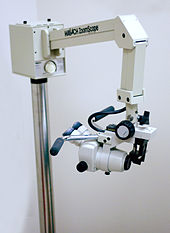Prebiopsy examination methods in gynecology
Methods used for screening and diagnosis of precancers and carcinomas of the cervix. Due to the low invasiveness of the procedures, it is possible to examine the majority of women in the risk group. In case of suspicious findings, we indicate biopsy and histopathological examination to confirm the definitive diagnosis. In diagnosis, we start with oncocytological screening, in case of suspicious findings, we continue with colposcopy and HPV typing.
Oncological cytology[edit | edit source]
A basic screening method (cervical cancer) to which every woman from the age of 15 is entitled. It is carried out once a year, as part of a preventive inspection. In order to increase detection, it is advisable to supplement it with an HPV test (especially for women over 30 years old).[1]
The classic method consists in taking a sample of cells from the examined tissue and then observing the stained preparation with a light microscope. The sensitivity of the examination corresponds to 55-90%. Newer methods (LBC – cytology in a liquid medium) do show a slightly higher efficiency, but they are too expensive for routine use, in the Czech Republic we indicate them rather exceptionally.
Sampling and evaluation of material[edit | edit source]
We use a suitable tool (preferably a brush) to smear cells both from the ectocervix, from the entire junctional zone (the junction of two epithelia, squamous and glandular) and from the endocervix. Place the collected material on a glass slide and fix it with 95% alcohol. The preparation is stained according to standard Papanicolaou (nuclei - hematoxylin, cytoplasm - orange G).
With LBC, the brush is immersed in a liquid and then the cell sediment is processed in the laboratory.
To evaluate the material, we use basic descriptive diagnostic terminology according to the Bethesda system. In addition to the cellular changes of the squamous and glandular epithelium (enlarged nuclei, irregularities in the shape of cells and nuclei, changes in staining), it also includes the quality of the coating, possible infection and hormonal status.
High-risk HPV typing (HPV-HR test)[edit | edit source]
Detection of DNA or mRNA of the most common high-risk HPV viruses in the collected sample. It is a method with higher specificity (93%) and higher sensitivity (95%) than cytological examination. Due to the high prevalence of HPV in young people, it is advisable to carry out this examination only in women after 30 years, when the persistent virus is the cause of the development of malignancies.
It is becoming more and more popular worldwide as a routine screening method for women over 30 years of age. In the Czech Republic, as part of screening, it is paid for for women aged 35 and 45, due to financial demands, cytology remains the basic examination. It is also indicated in the case of abnormal cytological findings and when checking the persistence of the HPV virus 6-12 months after removal.
Colposcopy[edit | edit source]
Imaging method for visual evaluation of the cervix and anogenital landscape. It allows to determine the severity and surface extent of the lesion and to assess its relationship to the endocervical canal. It is performed using a colposcope, which is a binocular optical device (on the principle of a telescope), with a magnification of 8-40x and a strong light source. From suspicious areas of tissue, we take samples for cytological examination and biopsy.
Basic colposcopy of the cervix is performed after the insertion of mirrors and removal of mucus. It includes observation of basic changes (inflammation, source of bleeding) and identification of suspicious sites. Normal findings include ectropion, squamous epithelium, and a transformation zone. White epithelium, stippling, mosaic and vascular atypia are evidence of an abnormal finding..
IIf there is a suspicious finding, we perform an extended colposcopy, which consists in the application of a 3-5% acetic acid solution in the area of the suppository, which will clarify the presence of pathologies (whitening of the areas - delayed in LG lesions, striking in HG). Another test is performed by applying Lugol's solution (it shows glycogen in squamous cells of the epithelium, cylindrical cells without glycogen are not stained), when atypical cells turn yellow-orange..
Expert colposcopy requires many years of experience, but it makes it possible to estimate the severity of the finding with great accuracy. We complete the examination with a cytological examination of samples from suspicious areas.
Links[edit | edit source]
Related links[edit | edit source]
- Prevention of gynecological tumors
- Precancers in gynecology
- Cervical precancers
- Treatment of precancerous gynecological tumors
- Malignant tumors in gynecology • Malignant tumors of the cervix • Malignant tumors of the vulva and vagina
External links[edit | edit source]
- www.onkogyn.cz (stránky Onkogynekologického centra VFN, např. aktuální TNM klasifikace)
Reference[edit | edit source]
- ↑ VZP. Screening karcinomu děložního hrdla od roku 2021 [online]. ©2021. [cit. 2021]. <https://www.vzp.cz/o-nas/aktuality/screening-karcinomu-delozniho-hrdla-od-roku-2021>.
Used literacure[edit | edit source]
- DVOŘÁČKOVÁ, Jana. Validita cytologických nálezů: kurz cytotechnologie. Ostrava. 2010.
- KOBILKOVÁ, Jitka. Gynekologická cytodiagnostika. 2. edition. Praha : Galén, c2006. ISBN 8072623133.
- ROB, Lukáš – MARTAN, Alois – VENTRUBA, Pavel, et al. Gynekologie. 3. edition. Praha : Grada, 2019. 356 pp. ISBN 978-80-7492-426-2.





